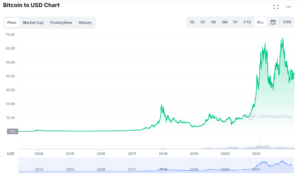Since the birth of Bitcoin in 2009, cryptocurrency has become a fast-growing asset that has brought about a revolution to the financial and technological landscape. A report shows that the global cryptocurrency market reached a value of US$ 1,782 billion in 2021 and is projected to be US$ 32,420 billion by 2027, demonstrating a 58.4% compound annual growth rate in the next five years.
The high net worth individuals (HNWIs) is one of the pivotal investors driving the growth of cryptocurrencies. According to research conducted by deVere, 68% of high net worth individuals are either already cryptocurrency investors or intend to be by 2022.
Why are HNWIs Investing in Cryptocurrency?
HNWIs tend to be cautious investors, but they are usually more sensitive and adaptable to the latest market changes than traditional wealth management institutions. Hence, HNWIs are emerging as one of the cryptocurrency market’s leading forces and active investors. And Capgemini’s report suggests that “the strong demand for information on cryptocurrencies from younger HNWIs is likely to force wealth management firms to at least develop and offer a point of view during the months ahead.”
By investing in cryptocurrency, HNWIs buy a promising asset that allows them to win more and lose less if they hold the cryptocurrency long enough. Bitcoin soared over 70% in 2021, outperforming the gold and S&P 500 overwhelmingly for three consecutive years. And if you bought Bitcoin with US$100 in 2011, after one decade, it is worth more than US$4 million.
Time cannot be reversed, and only a few people could grab the chance to become early Bitcoin investors. But as “late comers” to the cryptocurrency market, HNWIs could still enjoy various benefits in their wealth accumulation journey.

Bitcoin outperformed stocks and many traditional assets over the past decade. Source: coinmarketcap.com
Cryptocurrencies Could be Risk-averse
While cryptocurrencies such as BTC, ETH and numerous altcoins are highly volatile, stablecoins are risk-averse in nature. USD stablecoins like USDT and USDC are well-known choices among crypto investors who seek lower risk while earning high interests.
As the name suggests, USD stablecoins are pegged to the U.S. dollar. That means every dollar-worth of stablecoins must have an equivalent-valued asset behind them as reserves. Therefore, the exchange rate between USD stablecoins and USD can be maintained at around 1:1 for most of the time, unlike BTC or ETH, which have more volatile fluctuations. That’s why USD stablecoins are suitable for investors looking for stability and relatively higher returns.
In addition, cryptocurrency is borderless, perfectly fitting to the globalized investment world that HNWIs live in. Regions and countries do not limit the circulation of cryptocurrencies. Transactions do not need to go through international settlement systems such as SWIFT or even a bank.
And in times of insecurity, cryptocurrency could even be a secure way to protect your asset. As crypto wallets are universal, international transfers are unimpeded even in wars and social instability. Imagine you are escaping from your home during a war, cryptocurrencies will be more portable and safer than assets such as cash or gold. An unlimited amount of cryptocurrency assets could be stored in a crypto wallet without worrying about portability or robbery.
Could Bitcoin Replace Gold as the New Safe Haven?
Cryptocurrency supporters sometimes describe Bitcoin as “digital gold”, suggesting it can become a safe haven while the stock market is highly volatile. However, this theory cannot stand the test of time as the stocks and cryptocurrency markets have been performing roughly the same in recent months.
In 2021, Bitcoin experienced a sell-off wave under the downturn in U.S. stocks. The IMF warned that Bitcoin’s correlation coefficient to the S&P 500 was 0.01 from 2017 to 2019, but it rocketed to 0.36 in 2020-21 as central banks flooded markets with liquidity. That means the stock price and the value of Bitcoins are moving in line with each other.
Moreover, in the interest rate hike cycle, money flows to stable assets such as U.S. government bonds, while the attractiveness of the volatile crypto market seems to be relatively reduced. HNWIs must pay extra attention to this risk when including cryptocurrencies or stablecoins to create a risk-diversified portfolio.



